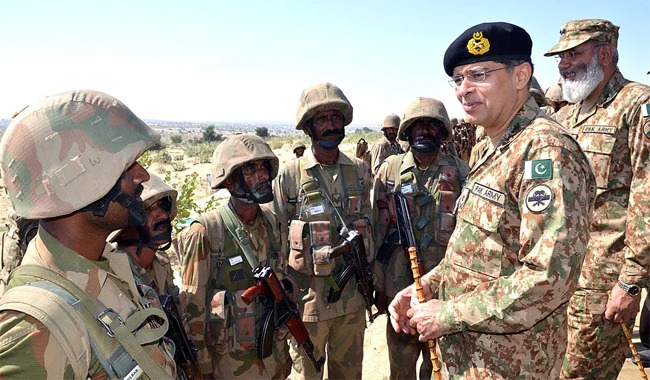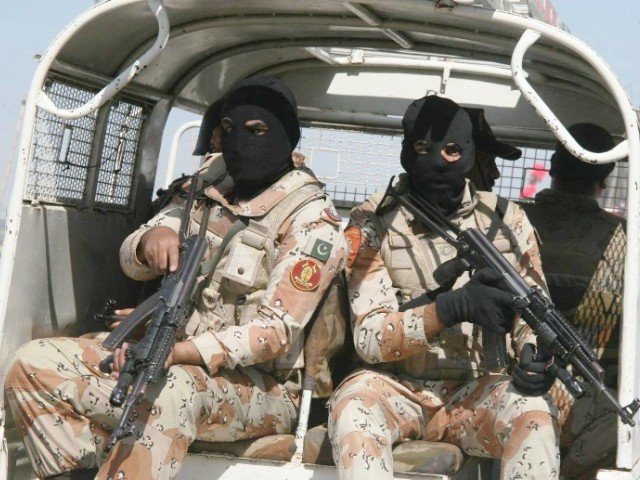Karachi is Pakistan’s financial capital, the country’s largest city and one of its most dangerous. In addition to crimes common to most big cities, organised gangs of extortionists, land grabbers, mercenaries in turf wars among political parties, ethnic groups and criminal gangs protected by political parties complicate the city’s law and order woes. For decades, Karachi has held a Place of unenviable prominence in terms of sectarian, political and ethnic strife that had increasingly become violent over the years. To this mix terrorist and extremist outfits with their own agenda of mayhem and death turned Karachi into a bubbling volcano waiting to explode. With the city suffering a major breakdown in law and order the Rangers started an operation in Sept 2013 aided by law enforcement agencies. By the end of 2015 nearly 7000 operations were carried out that led to a 70% reduction in target killings, 85% reduction in extortions and 90% reduction in kidnappings for ransom. There are now signs that the Karachi situation is moving towards a possible denouement, but there is little indication as to how the other crisis will be resolved. The criminalisation of politics and politicisation of crime is a major problem in Karachi, almost all major political parties have criminals in their ranks protected and patronised by politicians. Seventy years into Pakistan’s existence, we seem to have learnt no lessons from the crises that engulfed us even after losing our eastern wing in 1971. All big cities in the world have a saturation point, beyond an economic fail-safe limit, anarchy will result. For the benefit of readers I am reproducing my article titled “PREVENTING SLIDE INTO ANARCHY”.
Once known as the ‘City of Lights’ for its vibrant night life, a good part of Karachi lives in almost darkness, devoid of continuous power. This mega city’s momentum has led the nascent nation’s economy as the financial and commercial hub of Pakistan, Karachi accounting for a lion’s share of Pakistan’s revenue (some even claim 65% to 70%).
Not too long ago Karachi was held hostage to all manner of criminality of the murderous kind. Militants unleashed by political parties blatantly ran riot in both urban and rural areas, indulging in outright crime, killings, extortion, kidnapping for ransom, etc. All the three political par ties PPP, MQM and ANP running the ruling coalition in Sindh were part of this version of “good governance”. Karachi would come to a virtual halt on the whims of Altaf Hussain, with MQM militants running amok, threatening the citizens openly, ambushing police patrols, using rocket launchers on govt offices and police stations and fighting pitched battles with paramilitary forces in the streets. Even though PPP kept MQM somewhat in leash, courtesy bags of money delivered to Altaf Hussain by Rahman Malik in London to feed his gambling addiction, for decades Karachi was in a state of internal siege.
Maj Gen ljaz Chaudhry, than DG Rangers Sindh, really deserves the credit for initiating the enhanced gathering of real-time intelligence while re-organizing the Rangers to carry out targetted operations, and then starting it in 2012. The situation started to show moves towards normalcy. With ljaz promoted as Corps Commander Karachi he kept the momentum going, Rizwan Akhtar just got the credit. There was brief period of about 8-10 months of “no action” when ijaz’s undeserving successor had personal “priorities” before retiring in 8-9 months, countering terrorism was not anywhere one of them. This individual’s successor as Corps Commander, Lt Gen Naveed Mukhtar, not only restored the process but through the DG Rangers Maj Gen (now Lt Gen) Bilal Akbar he substantially increased the momentum.
Matters came to a head on Aug 22, 2016 when MQM chief Altaf Husain’s vitriolic speech calling Pakistan “a cancer for the entire world” instigated a gameplan to defame the Rangers and by default the Army. Armed to the teeth, MQM activists took up ambush positions in and around Zainab Market, a heavily congested area, within minutes of Altaf’s speech hidden in nearby buildings, including banks because of bank officers affiliated with MQM’s Labour Wing. This was not a spontaneous reaction but method in Altaf Hussain’s. Had the Rangers had not been delayed reaching Zainab Market because of traffic, hundreds of innocent civilians would have been deliberately murdered, would have been blamed on the Rangers, and by extension the Army. Playing the politics of dead bodies whether they were his followers or others was immaterial to Altaf Hussain as long as they fulfilled his nefarious designs.
With MQM being openly used as an aim of RAW, Lt Gen Naveed Mukhtar consulted with his commanders and decided that enough was enough. MQM’s had 102 sector/unit offices in 212 different locations across the city, 100% illegally occupied and encroached upon, they were serving as centers of training, safe houses/hide outs, storage facility as and when required. Each location was occupied by hundreds of MQM cadres, trained in combat, weapons handling, urban fighting, etc., more or less like an Army unit. Headed by a Sector Incharge on whose one command hundreds of MQM activists could firm out in their localities to do bidding, they had the capacity of killing scores throughout Karachi simultaneously. Taking permission from the COAS Gen Raheel Sharif the day after Aug 22, 2016, Naveed Mukhtar ordered the demolishing of all MQM unit/sector offices in Karachi with the tacit political and administrative support of the Sindh Chief Minister Murad Ali Shah. The real irony is that many of the area’s residents, ostensibly MQM supporters, looted the premises before the offices were bulldozed. Coupled with the physical demolition of the offices, the psychological effect put paid to the MQM’s vaunted capacity to mobilize power over Karachi at will.

Because of Naveed Mukhtar’s decisive action the MQM’s ceased to be the force it once was. Breaking up into factions each has been trying to re-enter politics and regain some significance, engaged in a strategy to remain politically alive. MQM Pakistan is desperately trying to woo the Federal govt into reopening the sealed or demolished MQM offices, potentially subjecting the city to a one-way descent into chaos again. Naveed Mukhtar has carried this capacity for faceless ruthless purpose and efficiency into his post as DG ISI. Carrying out Qamar Bajwa’s decisive instructions, he eased the crisis at Faizabad without carrying out bloodshed to thwart the gam plan of our enemies and their agents desperately wanting to provoke a civil war.
Karachi Electric Supply Corporation (KESC) indirectly contributed to MQM’s agenda of violence, it being MQM’s cash cow. MD KESC Shahid Hamid was assassinated in April 2005 because he was undertaking action against a ‘corrupt MQM mafia in his organization’. Many MQM favourites or those related to MQM leaders, all undeserving, were appointed in KE on huge salaries, while in fact working for MQM, this further bolstered the Sector units. MQM’s vice-like hold over KESC was first questioned in 2009 when Abraaj Capital acquired a controlling stake in KE, subsequently renamed K-Electric (KE).
The injection of US$ 361 million of equity into the company by Abraaj resulted in marked improvement in KE’s performance, ultimately benefiting the consumers. The Chinese State-owned Shanghai Electric Power Company Limited (SEPCL) is now keen on purchasing KE, the deal is estimated at US$ 1.77 billion. Augmenting confidence in the economic indicators, SEPCL will invest US$ 9.5 billion towards upgrading/development of infrastructure, particularly the transmission and distribution system.
Because of an explosive mix created by ethno-political and sectarian interests, influx of terrorists, illegal weapons, drugs, etc., combined with lack of good governance, Karachi could easily cross the fail-safe line into chaos and anarchy if there is load-shedding again of the scale before Abraaj took over. Without the Chinese investment to increase the KE capacity, to end load-shedding and power outages. With its citizens thirsty and without power (no pun intended), this could lead us to power and water riots (water-pumping machines becoming inoperable). The MQM Pakistan demand for re-opening their offices and attempting to stop injection of the Chinese investment in KE is a part of the sustained hybrid warfare by India’s RAW against Pakistan. The consequences of a descent into total anarchy can only be imagined. Karachi’s future would then be quite dark.




